I headed for Thailand one evening in February 2023. Although I envisaged this journey several months before the departure, for some unclear reason I hesitated a lot with the buying of the ticket and thus the prices had gone significantly up. In order to pay for them as little as possible anyway, I decided to make two changes of planes, one in Istanbul and the other one in Hong Kong.
At first glance, this makes no sense at all, since the plane heading for Hong Kong almost flies over Bangkok and then I practically had to return westwards in order to reach the capital of Thailand (and this was cheaper???). But, then again, these are plane tickets I’m talking about and they have never followed some standard human logic.
My plan was to stay in Thailand for a month and to start with I had a hotel room booked only for the first five days. The idea was to decide on the spot in which direction I should proceed and how and how far I should transfer, although I did have the basic idea about the general movement around the country. The plan was for me to visit the north, continental part of Thailand first and then to go down south and the beaches.
I decided to stay in Bangkok for five days first in order to get rest from the plane trip and second in order to have enough time to visit what I was interested in. I also thought this would be ample time in case the airline lost my luggage. One can never be too cautious.
But, as it turned out, it was also important for me to have the time to meet with various people in Bangkok. Namely, to start with, a friend of a friend had been living in Thailand for a number of years and thus the two of us agreed to meet for a coffee once I arrived in Bangkok.
Then, a son of my friend from England also lives in Bangkok most of the year and the two of us had also started to arrange a meeting.
And finally, 5-6 days before my trip I found out that my nephew (the one that helps me with my blog) was also going to Thailand, moreover we flew to Bangkok on the same date, albeit by different companies. What a spectacular coincidence that was! When I called him we agreed to “meet up for a coffee in Bangkok on Friday.” It sounded great!
And so I headed for Thailand one evening in February 2023 and here is a map that shows what places I ended up visiting during my stay in this exotic country.
Before even starting with my trip, I had booked and paid for a taxi to wait for me at the airport. This was important since after the long and exhausting journey I arrived very late (after midnight), so I did not want to spend a single minute more than necessary looking for a taxi or exchanging money. I think this was a good decision.
Upon my arrival at the hotel, I took my things up to the room and then I went down right away to the hotel’s terrace that was directly beside a canal where I ordered a cold beer. It is important to ensure good hydration and sufficient quantity of vitamin B.
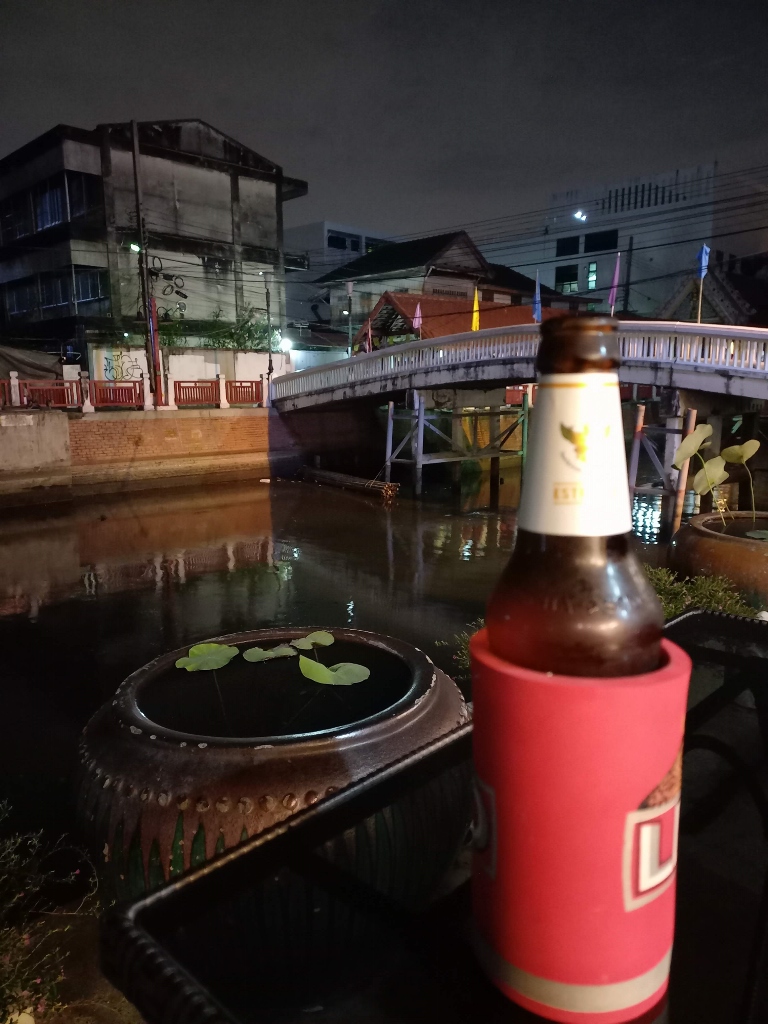 Hydrating of the body and maintaining the levels of vitamin B
Hydrating of the body and maintaining the levels of vitamin B
Although I slept long enough, probably because I went to bed quite late, I felt rather zombie-like when I woke up. Well, as we get older, one simply cannot do all the things that were done when one was young. So, I started my day very slowly because it was important for me to get used to the new time and the new climate, so I first had a coffee on that same terrace and now I could look at the canal and its surroundings in daylight.
 Canal in Bangkok
Canal in Bangkok
I had absolutely no plans for this day, apart from needing to get some local money. Regardless of the credit cards, I wanted to have some cash with me, since according to what I had read the Thai people prefer cash.
So, I left the hotel with intention to exchange some money and then possibly go and visit an important temple nearby.
Right around the corner I came across several stalls where food was being sold. Thailand and Bangkok are famous for their “street food,” but I must admit that I was surprised that already early in the morning there was this kind of offer of food as can be seen in the photos below. That was only because I was a novice here – by the end of my stay in Thailand I wondered no more. I realised that Thai people love to eat and this sometimes includes quite complex dishes, even during early morning. Or perhaps this was the place for them to buy food that they would eat later as lunch.
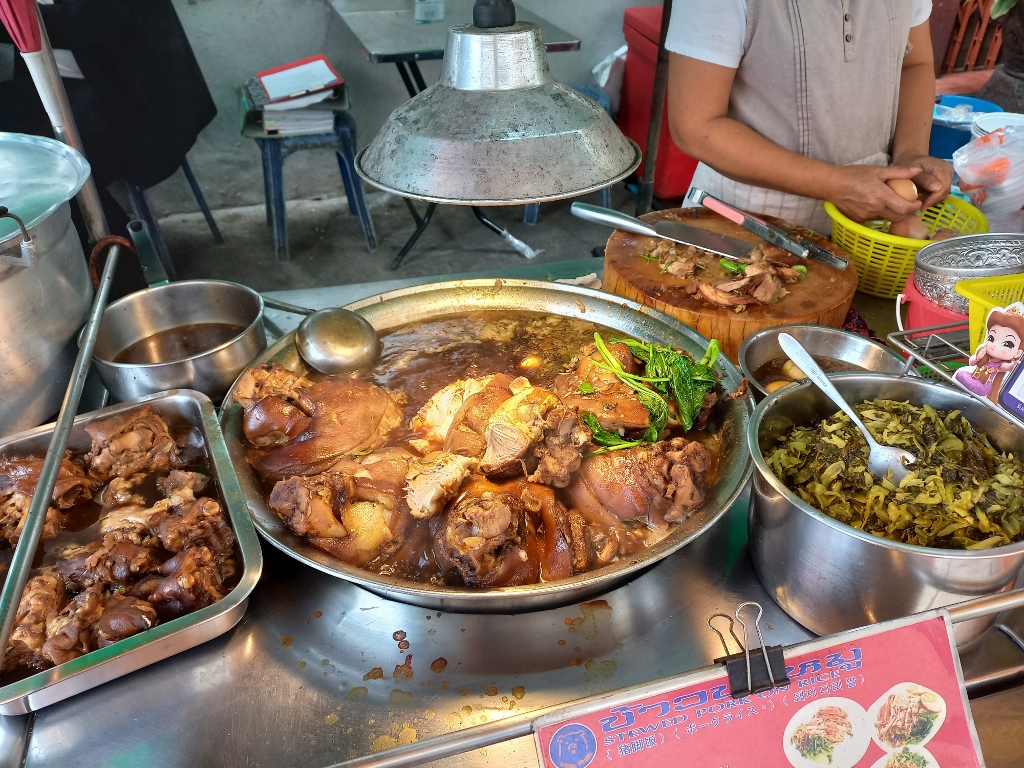 Street food in Bangkok
Street food in Bangkok
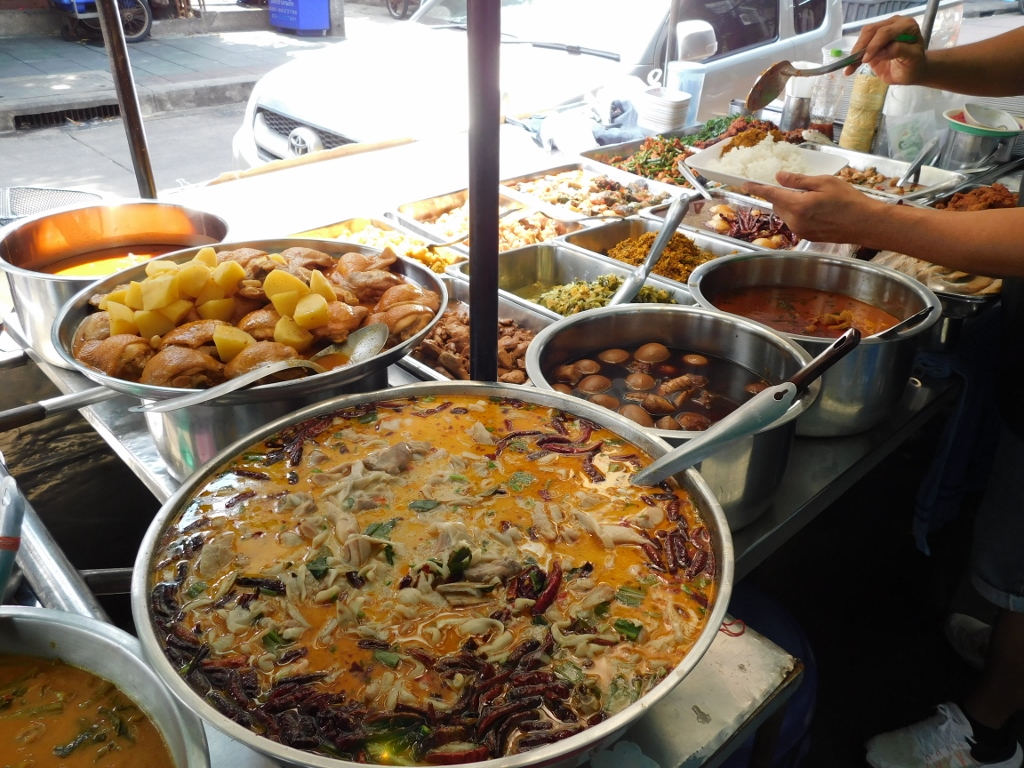 Street food in Bangkok
Street food in Bangkok
While looking for an exchange office, I reached a couple of streets that are very popular among foreign (younger) visitors, but I also started to get to know Bangkok a little. Thus, between two bigger streets in order not to go around, I followed an inscription and it took me through rather narrow lanes, but I eventually did get to where I wanted.
 I came from the left and I’m going to the right
I came from the left and I’m going to the right
There were many cafés and restaurants adjusted to the taste of foreign visitors in those two bigger streets, but there were also the unavoidable tuk-tuks – the fast and efficient public transport in Bangkok (as well as in many other places throughout Thailand).
 Tuk-tuks waiting for their customers
Tuk-tuks waiting for their customers
After I had changed the money, I realised that the morning heaviness was completely over, so I decided to go and visit that temple that I first had in mind.
I love to walk, so on this occasion I did not use any transportation. I also found it interesting to look at the city while moving at human speed. This is the right measure for me; especially when visiting places.
And so, I reached a boulevard where I was getting to know both Bangkok and Thailand. It needs to be said that in 2022 Thailand had almost 70 million inhabitants, while some 10 million of them lived in Bangkok. This entails large circulation of people throughout the day and Bangkok is (in)famous for its large traffic jams. On this morning and in this area there was no major traffic jam, but this was also my first encounter with the striking infrastructure in Thailand that made quite a strong impression on me. In the following photo it is possible to see that there are six lanes in this street!
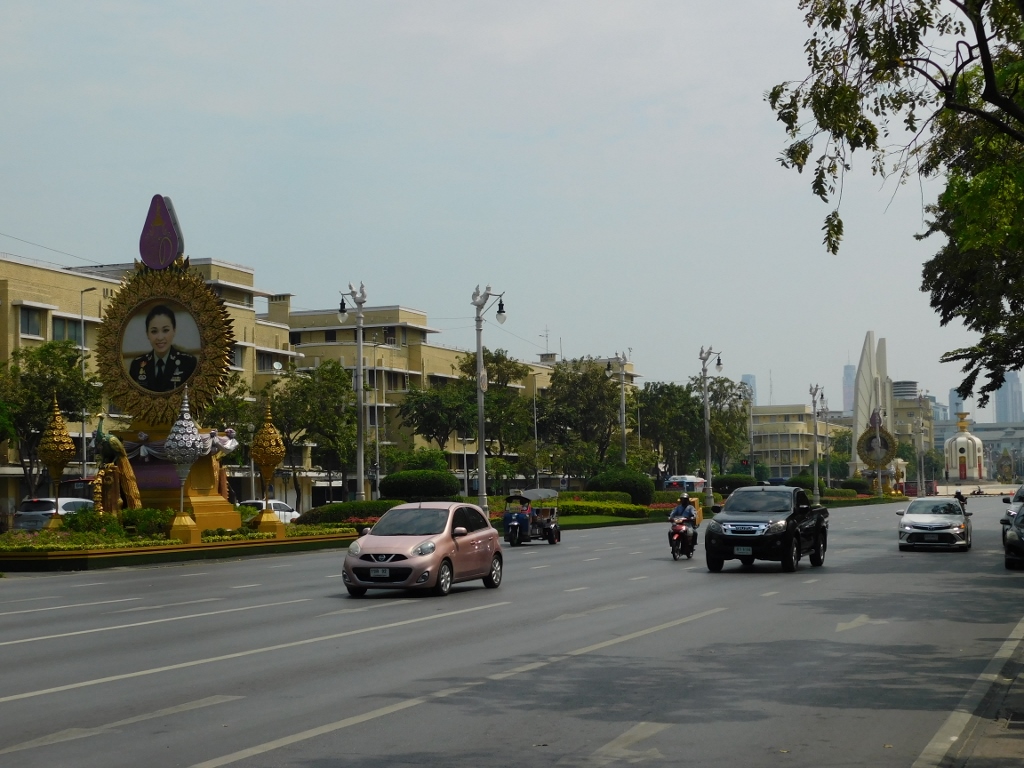 Bangkok, a detail
Bangkok, a detail
There are also a couple of interesting details that can be discerned in the photo. The first one is on the left-hand side. It is possible to see a photo of one of the members of the Thai royal family there. I must admit that neither during my trip nor later did I deal much with the Thai royal family, so apart from the king I would not be able to recognise any other member.
But, it is important to say that Thailand is a constitutional monarchy and therefore the king primarily plays a symbolic role. This does not mean that the Thai people are not keen on their royal family and even before coming here I had read that the visitors should make sure that they did not say anything that could be construed as insult to the Thai monarchy. I had no problems with that. Apart from not recognising who was in the photos that decorate a large number of streets, I have quite healthy respect for the Thai royal family. If they are good for the Thai people, they are certainly quite good for me, too.
Another interesting detail from the previous photo can be seen in the distance on the right-hand side of the photo. This is the Democracy Monument. The construction of the monument in the middle of a roundabout started in 1939, but I did not go into any details about the monument itself, its history and meaning, apart from reading in one of the slabs displayed in the vicinity that all the distances in Thailand, at least as far as the road traffic is concerned, are measured from here. Namely, the monument marks the kilometre 0.
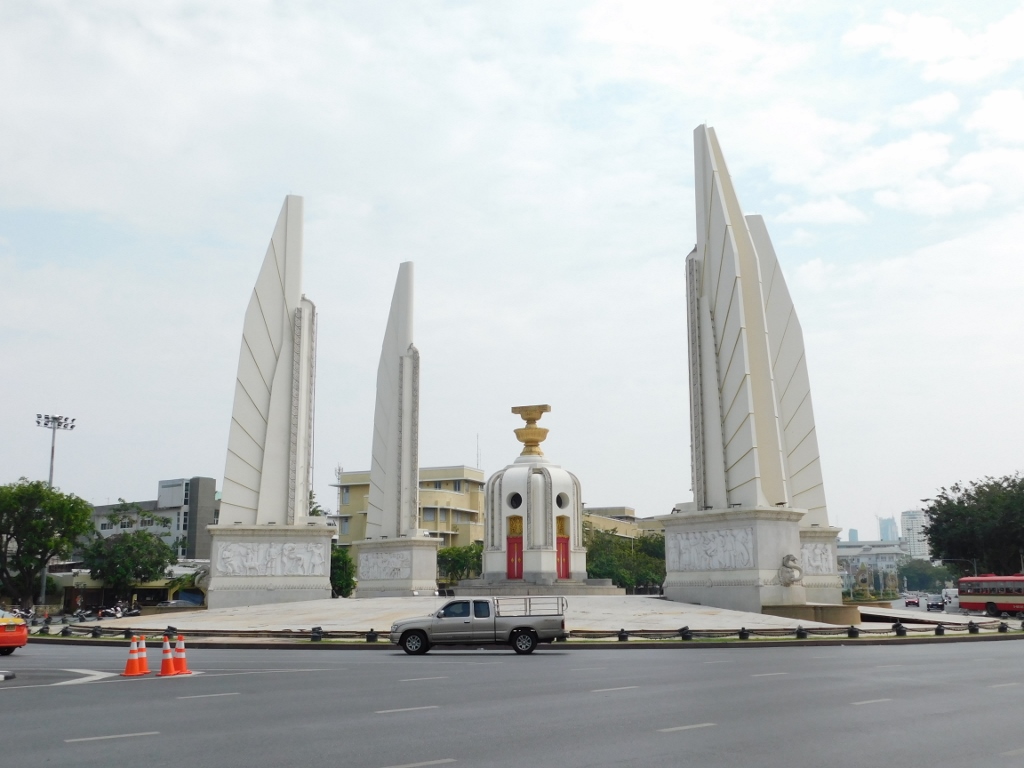 Democracy Monument
Democracy Monument
I continued walking towards that temple that I wanted to visit, but as it turned out the internet maps are not always good and when I was setting the route on my phone, my end point was the part of the city with the same name as the temple and these were two completely different things. In fact, the Google Maps took me to a wrong place, so I had to wander a little, but I actually liked the experience since I saw various picturesque details – a little bit of old, a little bit of new, as well as a little bit of blue...
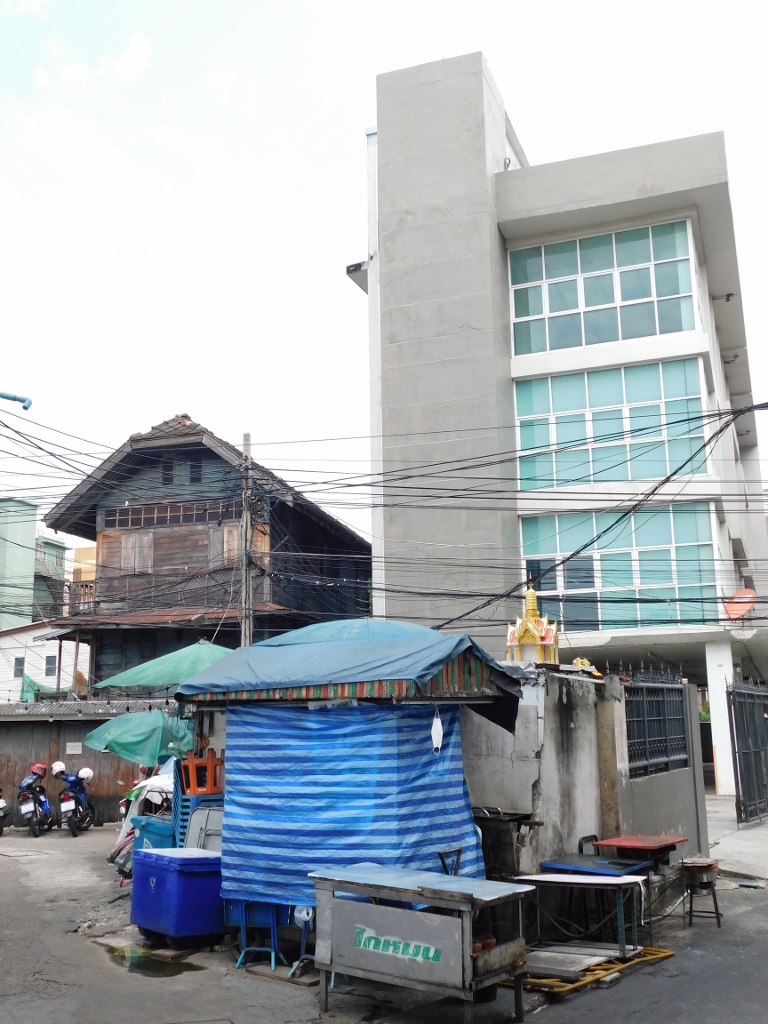 Bangkok, a detail
Bangkok, a detail
In the end, this was all for the best, because, while looking on the map, I realised I was close to a couple of important sites that I planned to visit anyway, although not necessarily on the first day. However, since I felt comparatively well, I decided to take advantage of the circumstances and visit as much as possible already on this occasion.
Thus I headed for the Golden Mount and the way took me literally beside yet another important temple, so I decided to go there first. This is a temple called Wat Ratchanatdaram.
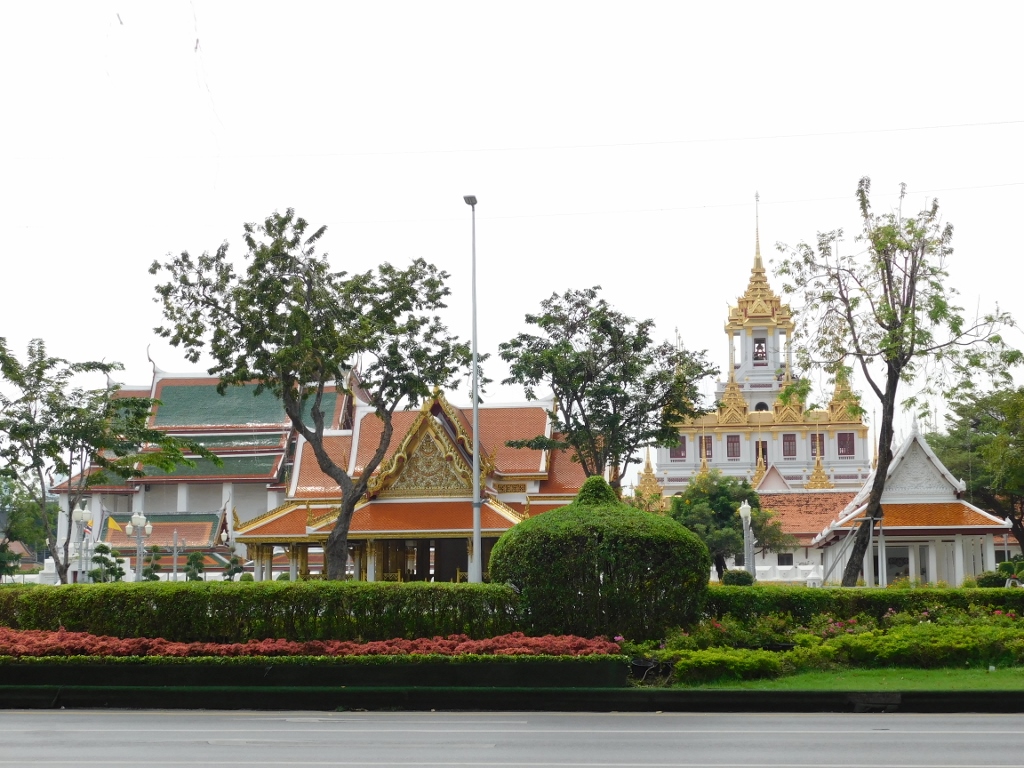 Wat Ratchanatdaram
Wat Ratchanatdaram
Let me first say that the word “wat” means in fact a Buddhist temple, but I will often in my travel stories use “temple Wat...” simple as a reminder of the function of the structure.
Second, different sources provide similar and yet different names for buildings or towns, for instance. I presume that the main reason for that is the transcription into the Latin script, since the Thai (Siamese) language uses its authentic script. Since I have absolutely no idea about Thai except that it is a tonal language (like Chinese or Vietnamese), I cannot judge how the transcriptions were done, so in my travelogue I will use those names that are used most often or that I came across most often.
An example for these “different” names can be given precisely in the case of this temple that I came across and its other name, Wat Ratchanadda, that I will neglect hereinafter.
There is another thing that is exceptionally important and it applies to ALL Buddhist temples in Thailand, as well as some other buildings, including also a museum here and there. The visitor must be ready to take off the shoes before entering the temple. In some places it is permitted to enter in socks, but there are some places where even this is prohibited. I was ready for something like this since I had learned in India and later Sri Lanka that neither the Hindu nor the Buddhist temples may be entered in footwear of any kind. For this reason, I like to visit such places in slippers/clogs so that I can take them off easily and just as easily put them back later on.
Having crossed the wide avenue, I actually first came across the Royal Pavilion Mahajetsadabadin from 1989 that was built in order for the king to receive his official visitors there. In line with this, the access to tourists and common visitors is not allowed.
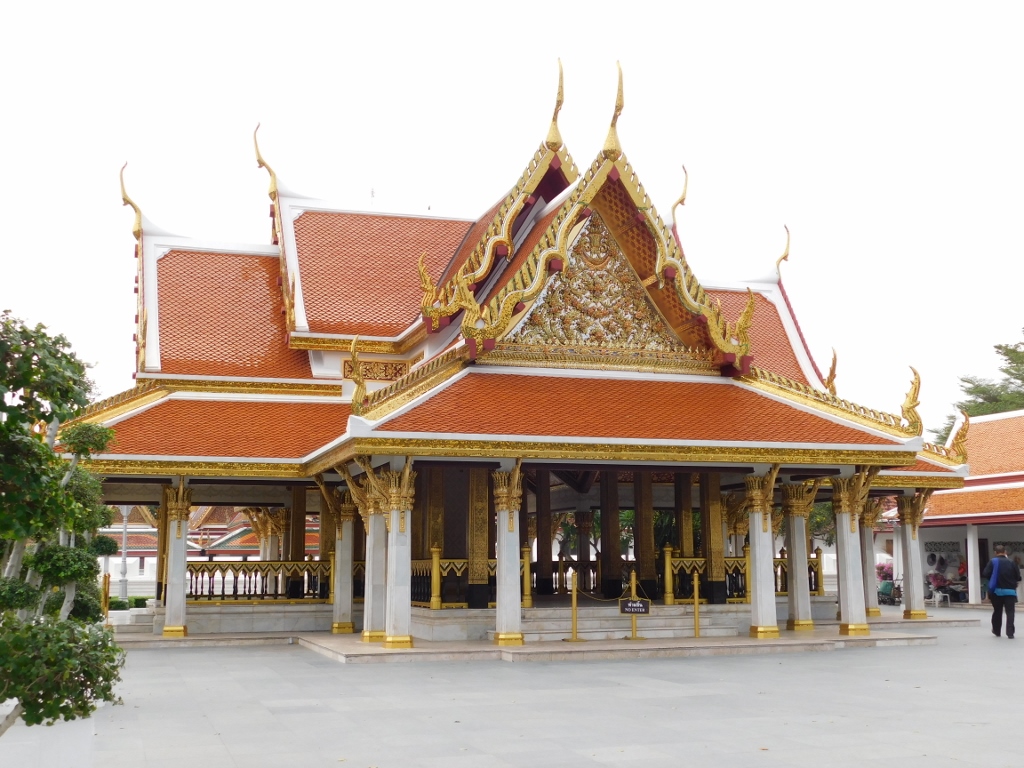 Royal Pavilion Mahajetsadabadin
Royal Pavilion Mahajetsadabadin
Since I just passed by the pavilion, I entered temple Wat Ratchanatdaram that was built in 1846 by Siamese (Thai) King Rama III (b/r 1788/1824-1851).
 Wat Ratchanatdaram, left, and the Royal Pavilion, right
Wat Ratchanatdaram, left, and the Royal Pavilion, right
Like most of the other temples that I visited here, this is in fact a temple complex. Namely, within each one of these temples there are usually several structures. Here I also started to learn some of the important terms used for different parts of the temple. By the end of my trip I got quite used to them, but I must admit that the difference between some of them was not completely clear to me. Then again, I didn’t think this was too important for me, since I’m not a Buddhist.
And so here, in the middle of the yard I came across an ubosot that represents the central building within a temple (temple complex) and this could be described as a sanctuary or the main chapel. Instead of ubosot it is also possible to use term “ordination hall,” since this is the place for carrying out a rite when the candidates for monks are ordained, but this space is also used for other ritual ceremonies, including some regular rites, prayers, meditations, reading of holy scriptures, etc. Ubosot is the most important building within the temples in central Thailand and it is often bigger than the other buildings and hosts a large, main Buddha figure with a myriad of smaller Buddha figures and various other ornaments, symbols, as well as figures of renowned monks and/or royal family members. Here, at temple Wat Ratchanatdaram, the shorter sides of the ubosot, which by the rule has a rectangular ground plan, face viharas, two of them, that were built at a right angle in relation to the ubosot.
 Wat Ratchanatdaram
Wat Ratchanatdaram
Vihara is yet another term linked to the Buddhist temples and in Thailand they often also use the term wihan, while the Christian equivalent would be the chapel. There are also figures of the Buddha inside, while the space is used for certain ceremonies.
In the previous photo, a vihara may be seen in the foreground, on the right-hand side, while to the left there is the ubosot, behind which there is the other vihara.
Although I did enter one of the viharas, I found the ubosot more interesting and so I took more photos of its details, such as the roof or the windows, while also taking photos of the interior.
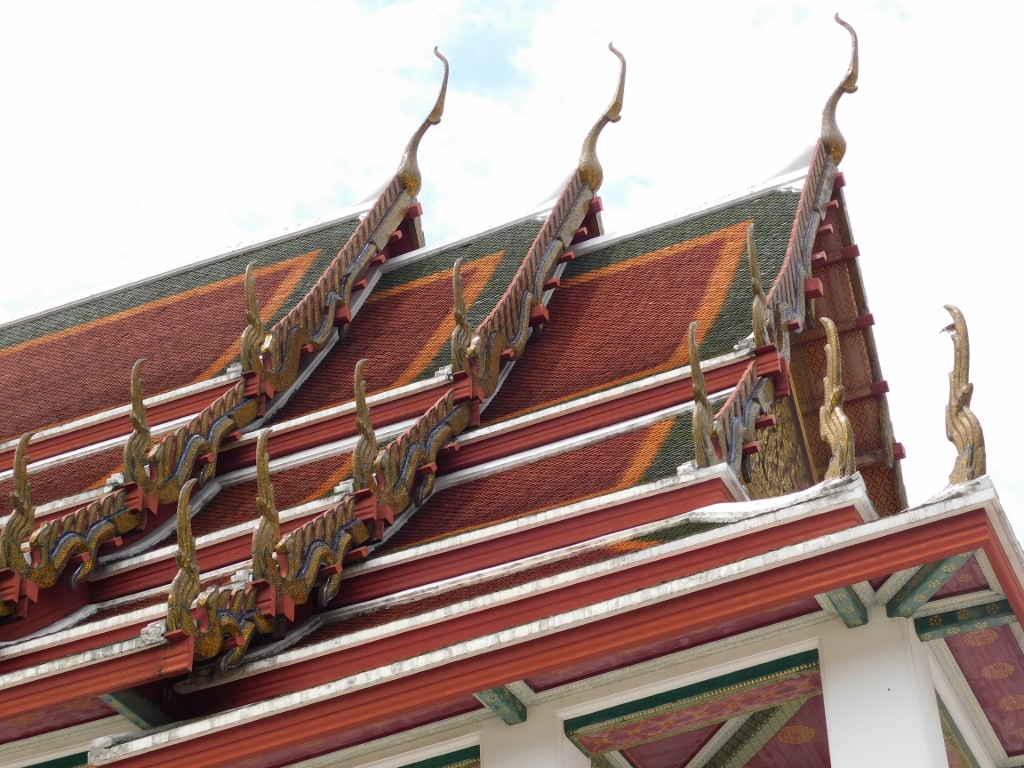 Wat Ratchanatdaram, a detail
Wat Ratchanatdaram, a detail
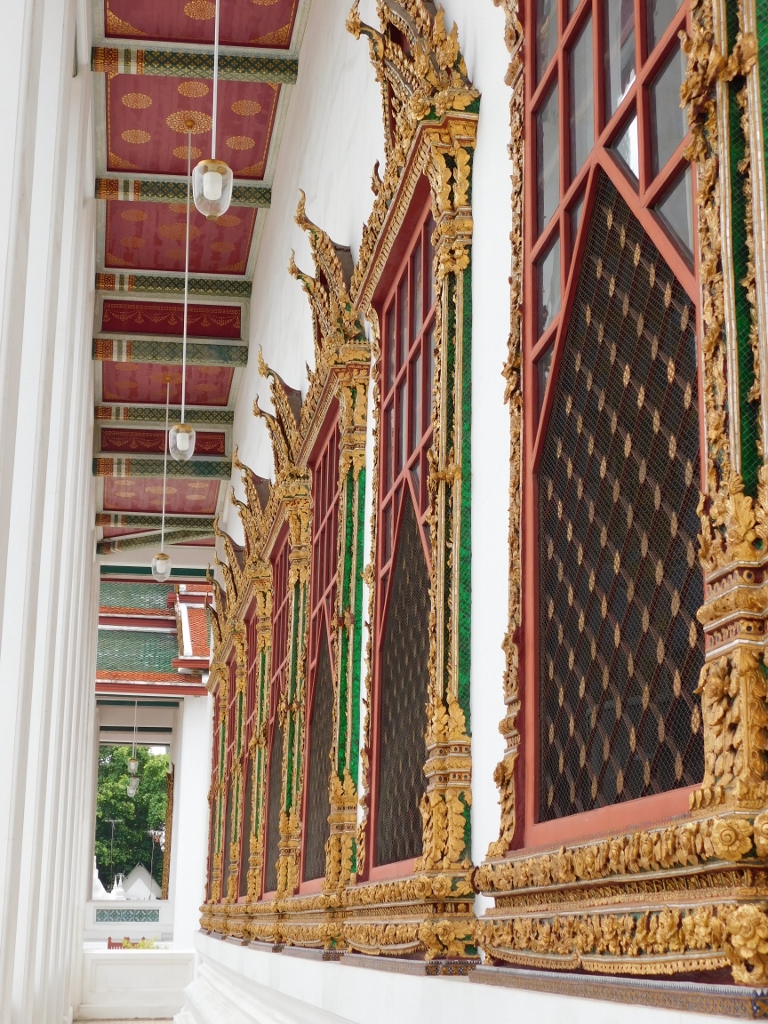 Wat Ratchanatdaram, a detail
Wat Ratchanatdaram, a detail
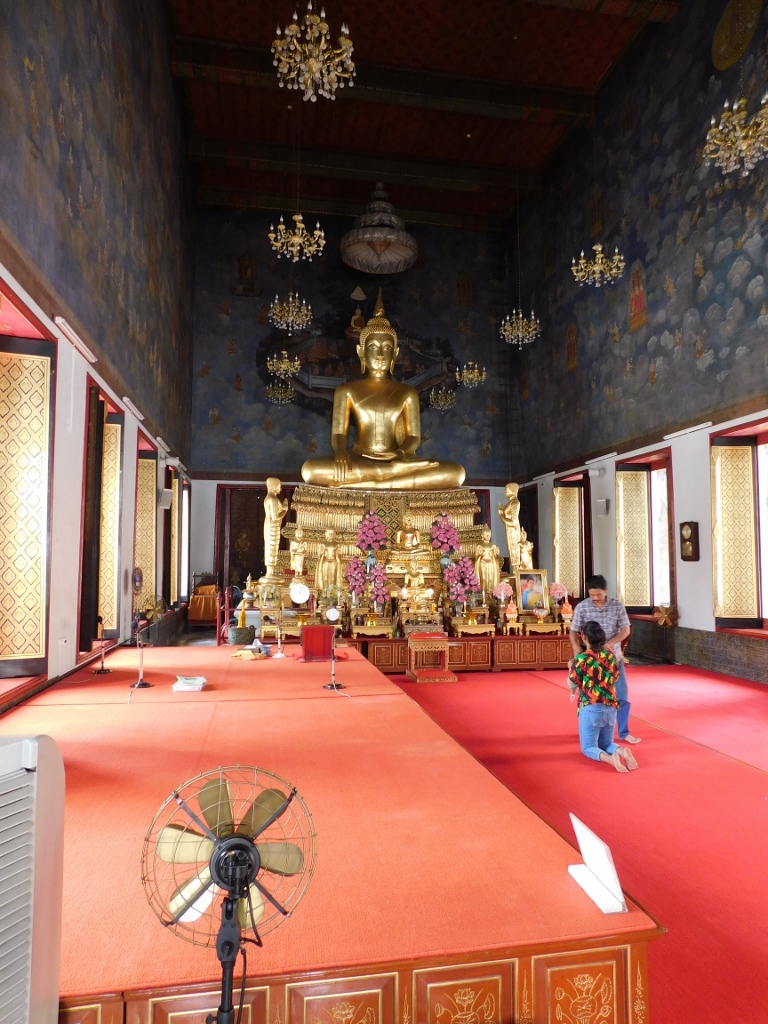 Wat Ratchanatdaram, a detail
Wat Ratchanatdaram, a detail
In the photo above, you can see clearly a “platform” on the left-hand side envisaged for monks alone and it is not allowed for visitors to use it. On the other hand, the Buddhists as well as others who would like to pray can do so without any problems, but it is important that while sitting or kneeling on the floor their feet do not face the Buddha. The reason for this is that in Thailand feet are considered a particularly dirty part of the body and if they face the Buddha then it is a major sign of disrespect. Because of this, people who pray either sit in a lotus position or they kneel like the woman in the photo or they sit on the floor while putting their legs bent in the knees to the side, so that the feet go behind the back.
All of these were details that I was learning already during the visit to my first temple in Thailand and this is why I’m mentioning it, for this was an abundance of new information that I needed to take in.
Then I left the ubosot and headed towards the part of the temple called Loha Prasat.
 Wat Ratchanatdaram, a detail
Wat Ratchanatdaram, a detail
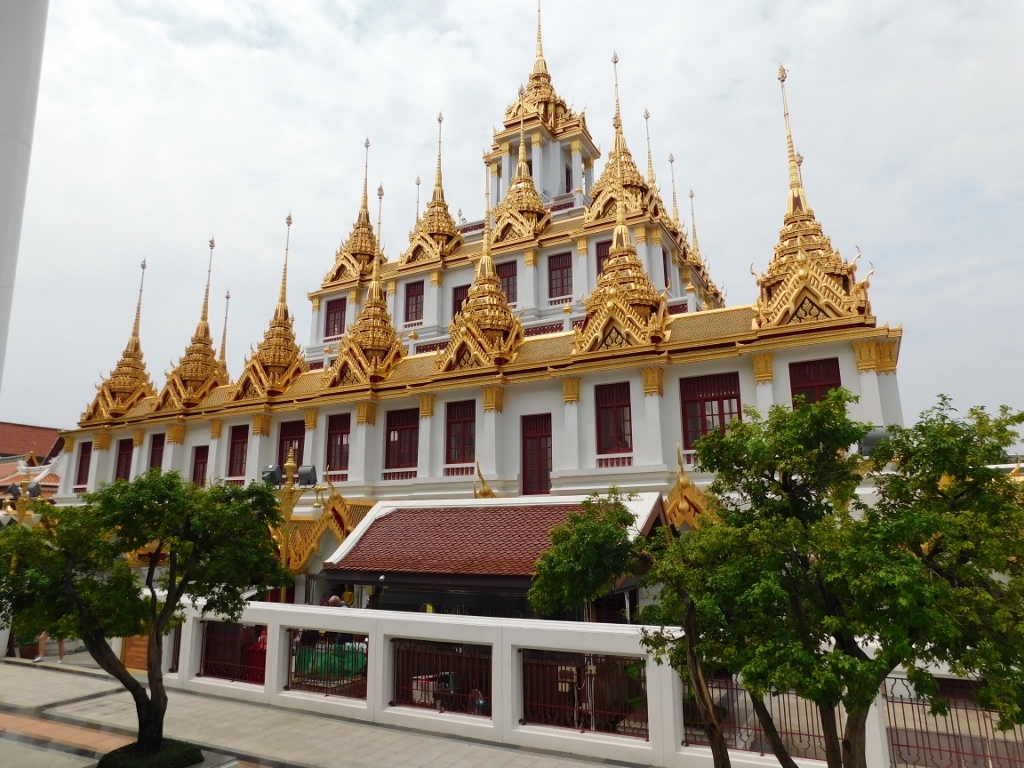 Loha Prasat
Loha Prasat
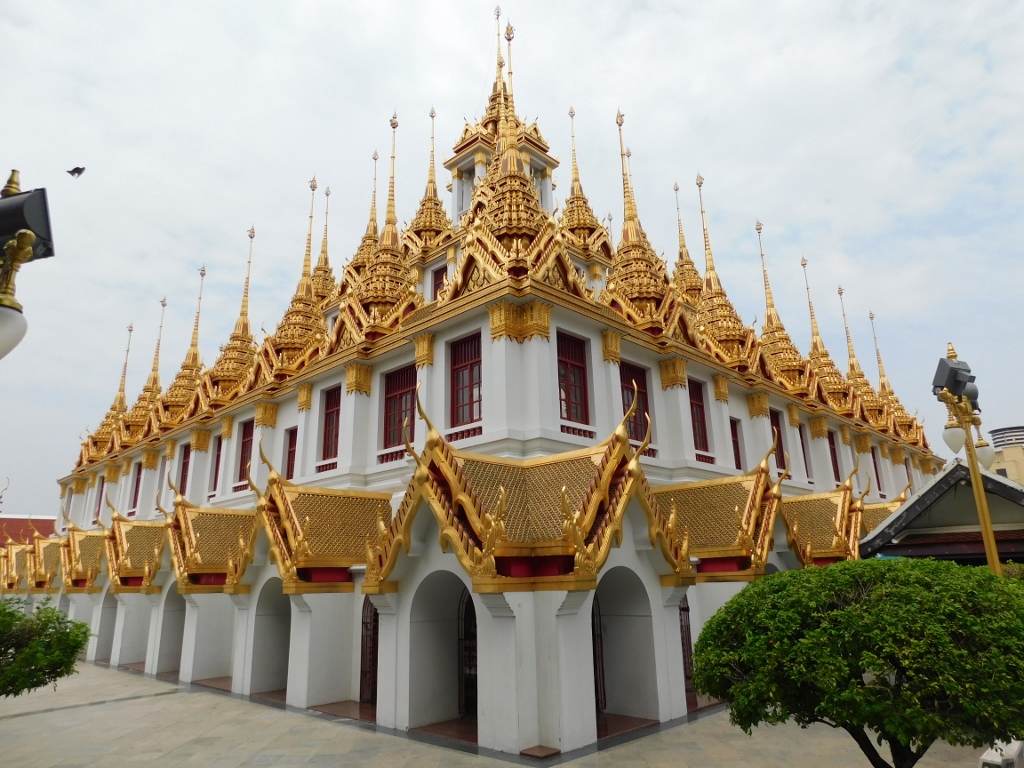 Loha Prasat
Loha Prasat
Loha Prasat was built following the paragon of similar structures that used to exist in India and Sri Lanka. These old structures do not exist any longer and thus this is the only building of the kind in the world. It was built from 1846 to 2007 and it has the form of a chedi, which is the Thai version of stupa. The chedi or the stupa is a structure in the shape of a semi-sphere or a square pyramid or a bell within which there are most often the relics of Buddhist holy people, including the Buddha himself, or the relics of various monks, both male and female. The chedi is also used for meditation.
Loha Prasat in Bangkok is 36 m high and has three floors (not counting the ground floor), as well as a small shrine on the very top. It is characterised by golden spikes, 37 of them in total, since they symbolise the 37 Buddhist virtues that are necessary in order for one to attain enlightenment.
On the ground floor there is an exhibition area, as well as numerous hallways that extend in-between pillars that carry the whole structure. In the middle of the building there are round stairs that go to the upper floors.
On each of the floors one can walk along the hallways and, as far as I could get it, each floor symbolises an important step on the path of enlightenment. The first floor is dedicated to the walking meditation. It is done by walking straight, to the front and then to the back, but for not more than 3 metres, all the time being aware of what is happening in the body. This helps develop concentration and awareness of the present moment.
The next floor is dedicated to the sitting meditation and there is also a slab where you can read clear instructions as to how to do this in the simplest possible way, when the meditant is aware of each breath they take in and release. Also, it is emphasised that this meditation need not necessarily be done while sitting, although the sitting position is certainly recommended.
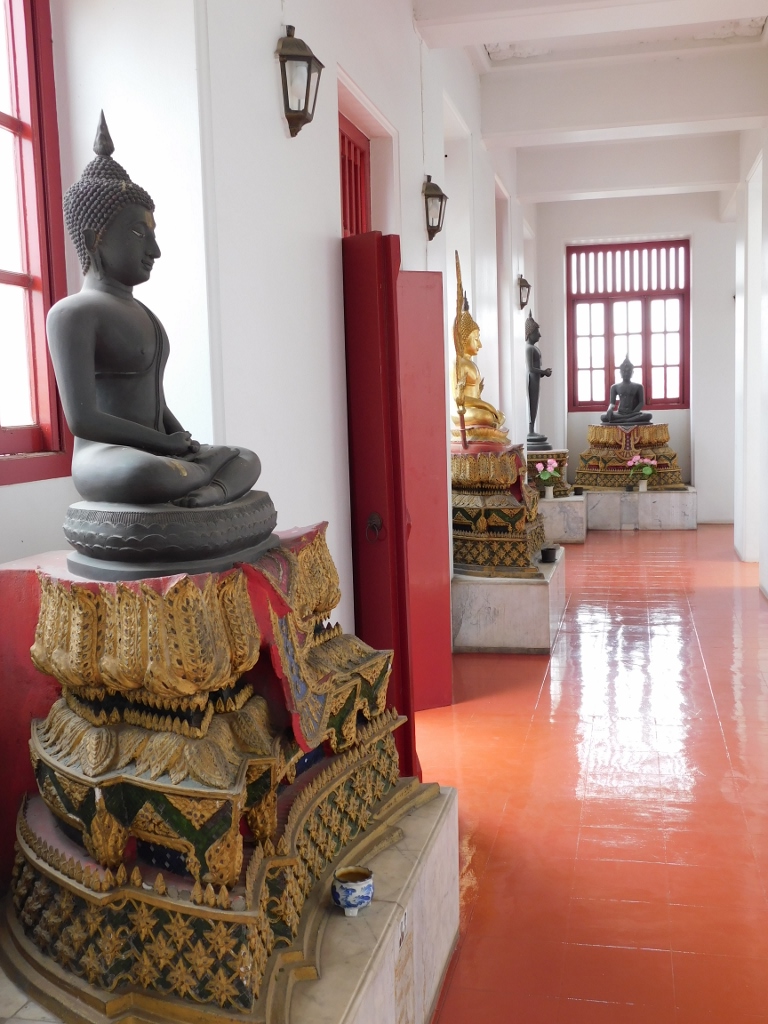 Loha Prasat, a detail
Loha Prasat, a detail
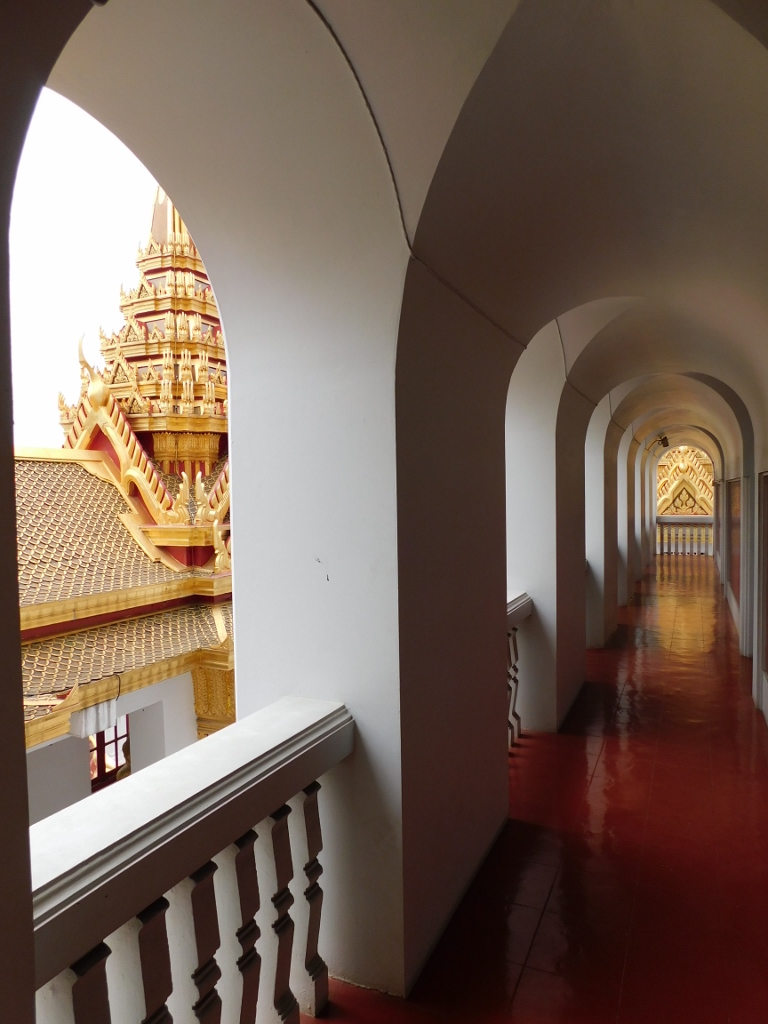 Loha Prasat, a detail
Loha Prasat, a detail
While walking here, without meditation, I could also take photos of some details both of the Loha Prasat and of the Wat Ratchanatdaram temple.
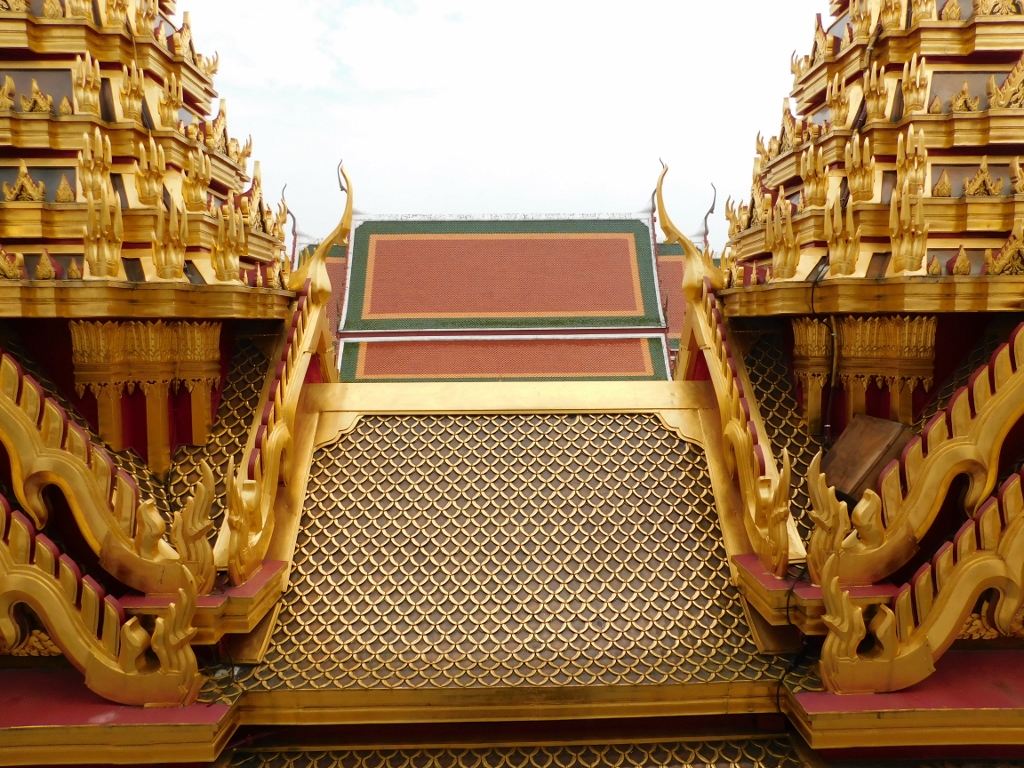 Loha Prasat and Wat Ratchanatdaram, a detail
Loha Prasat and Wat Ratchanatdaram, a detail
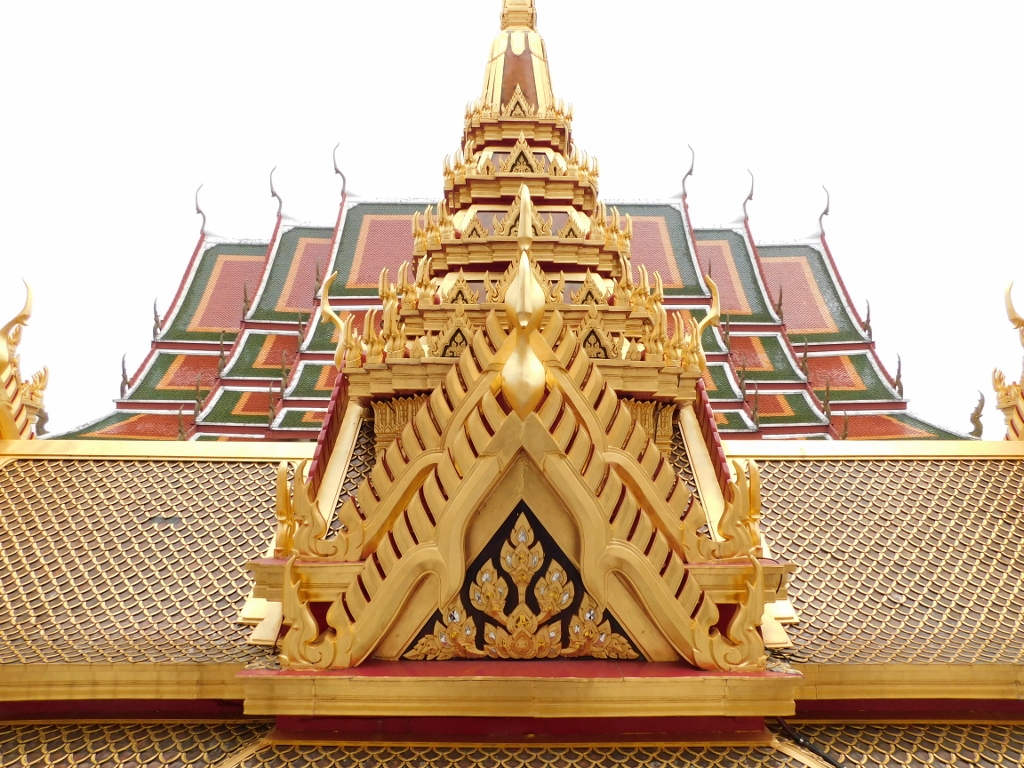 Loha Prasat and Wat Ratchanatdaram, a detail
Loha Prasat and Wat Ratchanatdaram, a detail
The third floor is dedicated to the noble or holy monks whose greatness comes from them reaching the moral conduct, concentration and wisdom, while in parallel abstaining from different impurities in the broadest sense of meaning.
But, on the third floor it is also possible to walk along an open terrace which allows one to enjoy the views in all directions. Here is what the view at the ubosot and two viharas of the Wat Ratchanatdaram temple looks like.
 Wat Ratchanatdaram temple complex
Wat Ratchanatdaram temple complex
I could also see another temple nearby, Wat Thepthidaram Worawihan, one name of which (!) also has different transcriptions into the Latin script which is, as I’ve mentioned, a frequent case. The temple was founded in 1836 and judging on the photos I have seen it is interesting, but I did not visit it. Perhaps the next time. In the distance I could also see the high-rise buildings of the modern part of Bangkok.
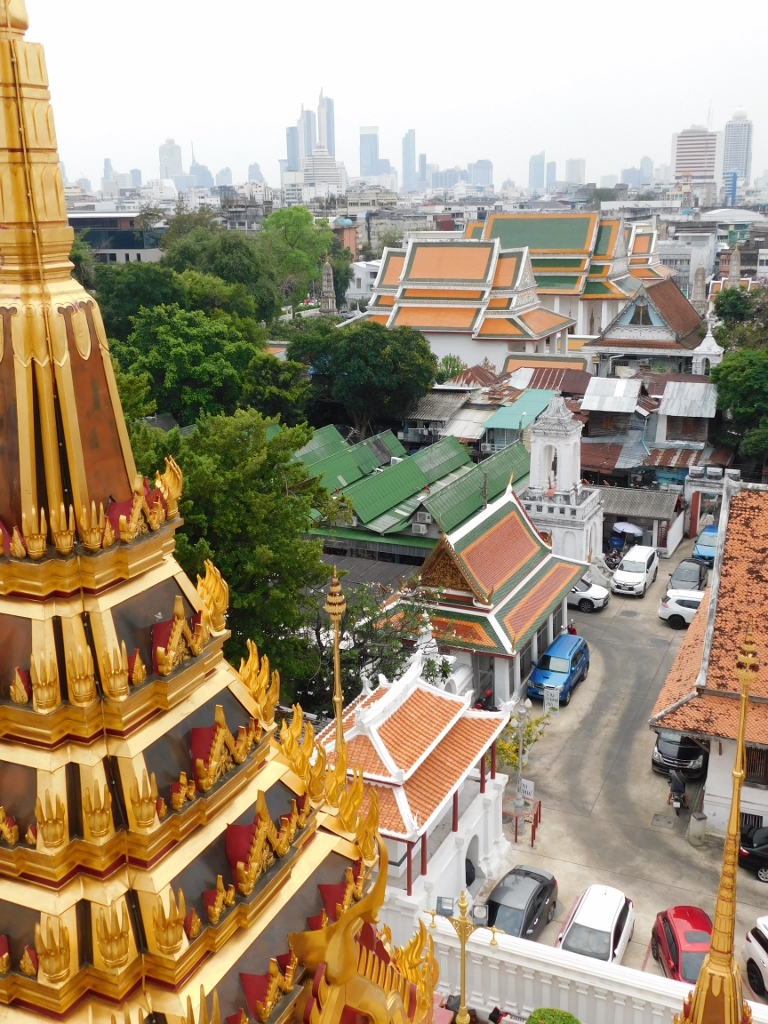 View at Wat Thepthidaram Worawihan and parts of modern Bangkok
View at Wat Thepthidaram Worawihan and parts of modern Bangkok
In the middle of the third floor there is a shrine which on the one hand symbolises the Nirvana, the state of sublime and final liberation in which frustration, confusion, passion and anxiety caused by ignorance, greed and hatred disappear, while on the other hand the shrine contains the relics of the Buddha. For this reason numerous believers come here in order to pay their respect and pray.
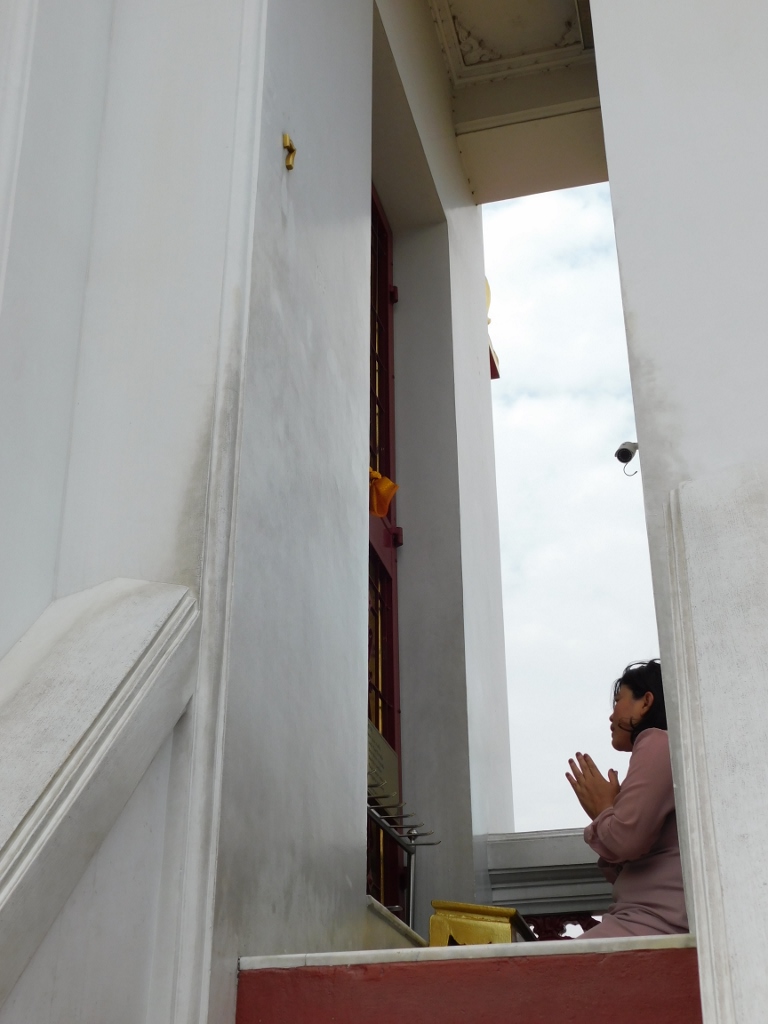 Loha Prasat, steps leading to a small terrace from which the shrine and a reliquary with the Buddha’s relics can be seen through a gridded door
Loha Prasat, steps leading to a small terrace from which the shrine and a reliquary with the Buddha’s relics can be seen through a gridded door
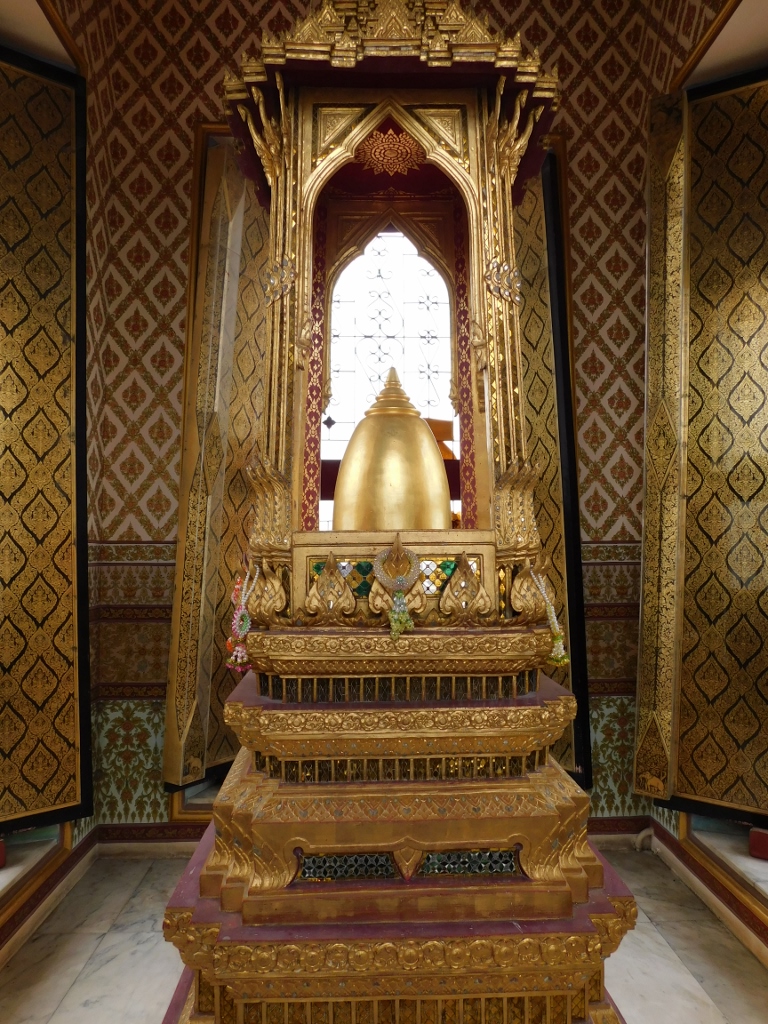 Loha Prasat, the shrine and the reliquary with the Buddha’s relics
Loha Prasat, the shrine and the reliquary with the Buddha’s relics